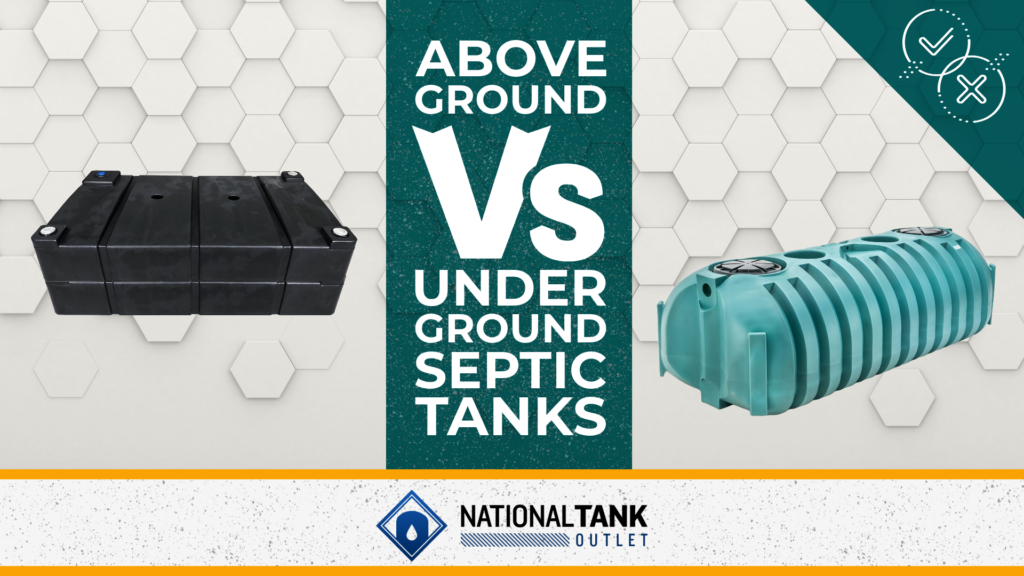
Septic tanks play a primary role in managing wastewater for homes and businesses not connected to municipal sewer systems. When properly used, they provide the safe treatment and disposal of waste while protecting both the property and the environment. When it comes to choosing a septic tank, there are two main options: above ground and underground septic tanks. Each option has distinct benefits and challenges and should be used for specific needs and circumstances.
This post will look into the key differences between above ground and underground septic tanks, so you can know when each type can or cannot be used. Factors such as how long the tank will be needed, permanence, durability, maintenance requirements, and site conditions all come into play, and understanding them is essential to selecting the best solution for your property.
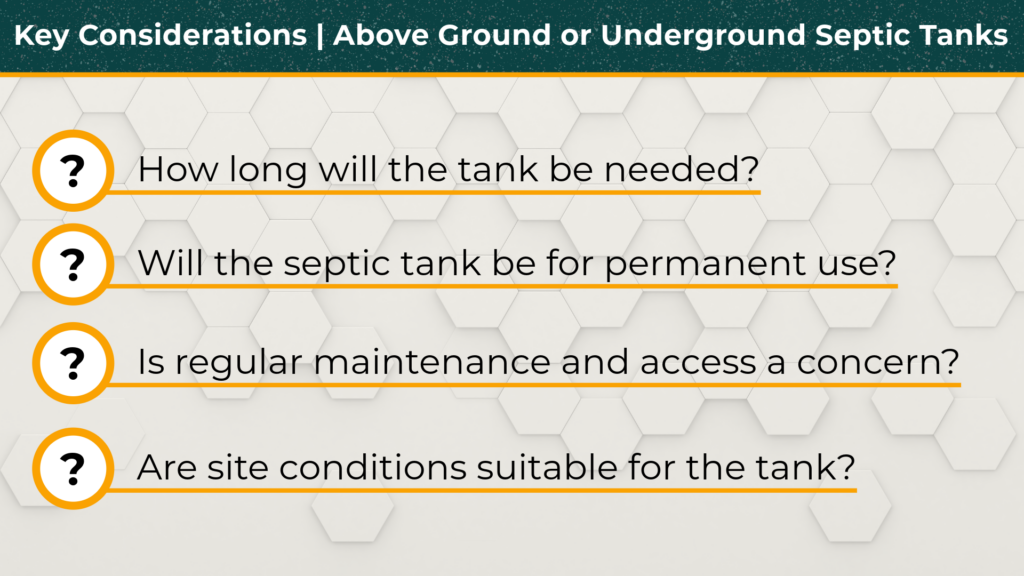
Whether you’re planning a new installation or considering a replacement, this guide will give you the insights needed to choose with confidence.
What Are Above Ground Septic Tanks?
Above ground septic tanks are self-contained wastewater storage solutions designed to rest on the surface of the ground rather than being buried. These tanks primarily function as holding containers for household or commercial waste and are often used in temporary or portable setups.
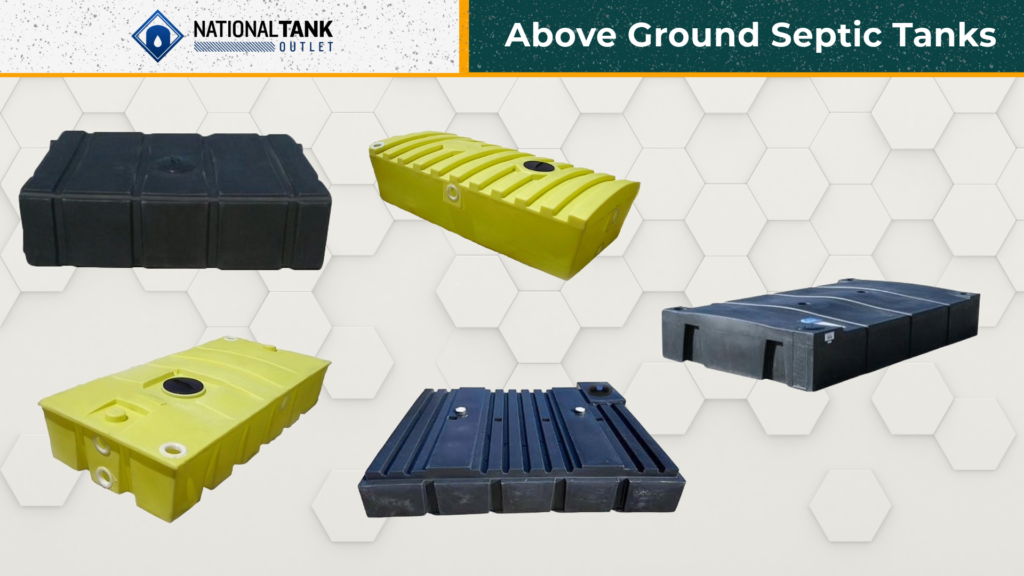
Commonly referred to as job site tanks, trailer tanks, cottage tanks, job shack tanks, or camper septic tanks, they offer a practical waste management solution in situations where permanent installations are not feasible, are planned for the future, or when soil conditions are unsuitable for underground systems. Unlike underground septic tanks, these systems do not have a treatment system or drain field and require regular pumping to keep the tank from becoming full.
Key Features of Above Ground Septic Tanks
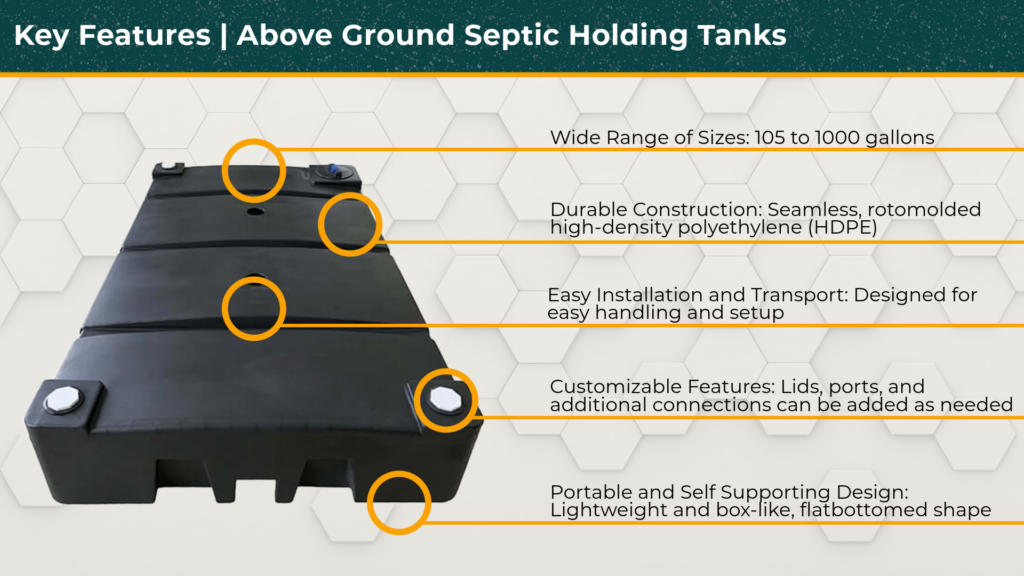
- Wide Range of Sizes: Above ground septic tanks are available in various sizes, typically ranging from 105 gallons to 1000 gallons, as offered by the National Tank Outlet. These size options make them adaptable for different needs, from small seasonal properties to large industrial job sites.
- Durable Construction: Made from high density virgin polyethylene resin, above ground septic tanks are seamlessly constructed through rotational molding. This process ensures they are seamless, lightweight, impact resistant, and physically strong. UV inhibitors are added during production to protect the tanks from sun damage when exposure is a concern.
- Portable and Self Supporting Design: Above ground tanks have a flat, low profile design that lets them fit easily under raised structures such as job trailers, motorhomes, and cabins. This shape enhances their portability and makes them self supporting to eliminate the need for additional brackets or supports.
- Easy Installation and Transport: Due to their low weight, these tanks do not require special equipment for placement and can be transported or installed by two people. With no excavation necessary, installation is significantly faster and more cost effective compared to underground tanks. This simplicity results in reduced labor and equipment costs, which is particularly beneficial for short term setups.
- Customizable Features: Above ground septic tanks are designed with recessed ports that accommodate couplers and clamps for flexible plumbing connections. They are available in opaque black, yellow, or white colors. Tanks may come equipped with pre-installed lids, ports, and additional connections depending on the tank type.
Common Uses
Above ground septic tanks are versatile and fully portable which makes them highly practical for the following scenarios:
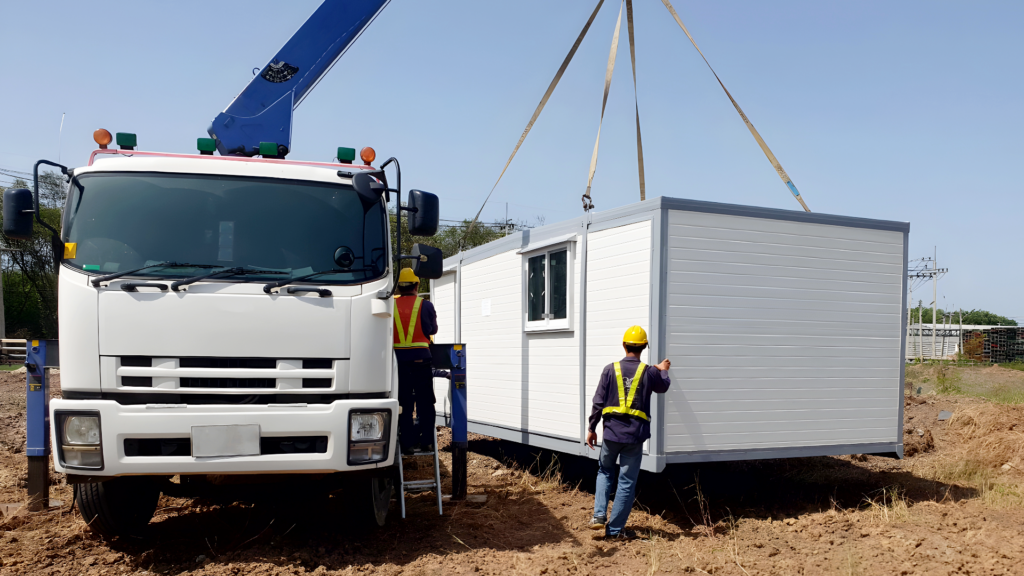
- Temporary Setups: Ideal for short term applications at construction sites, outdoor events, or during residential renovations. Their lightweight and portable design makes them easy to relocate as needed.
- Off-Grid and Seasonal Properties: Frequently used at rural homes, cabins, or mobile setups like RVs where permanent septic systems or municipal sewer connections are unavailable. Above ground tanks also serve as a temporary solution when an underground system is planned for future use.
- Industrial and Job Site Use: Commonly used as job trailer holding tanks or job shack tanks, these tanks are perfectly suited for construction sites, industrial facilities, and camping sites, where they safely store wastewater.
- Areas with Difficult Soil Conditions: When traditional underground septic installations are impractical — such as in regions with high groundwater levels, rocky terrain, or poor soil drainage — above ground tanks can offer a reliable and practical alternative.
With their durability, ease of installation, and versatility, above ground septic tanks remain an effective and cost efficient choice for wastewater management in temporary and portable setups. For a closer look at available models and sizes, visit National Tank Outlet’s extensive selection to find the perfect tank for your needs.
What Are Underground Septic Tanks?
Underground septic tanks are permanent, buried wastewater management systems that treat and store waste generated by household or commercial activities. These tanks collect and separate solids from liquids through a natural settling and breakdown process. Solids sink to the tank’s bottom to form sludge, while grease and other lighter substances float to the surface. The liquid waste (effluent) is then directed into a drain field for further filtration and absorption.
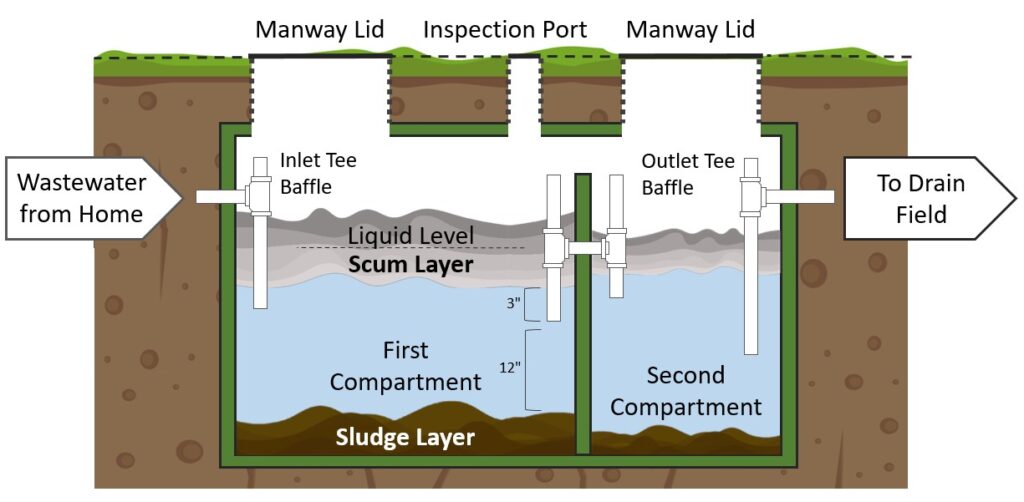
Their underground placement keeps the system secure and out of sight, making them ideal for permanent installations in properties without access to municipal sewer systems.
Key Features of Underground Septic Tanks
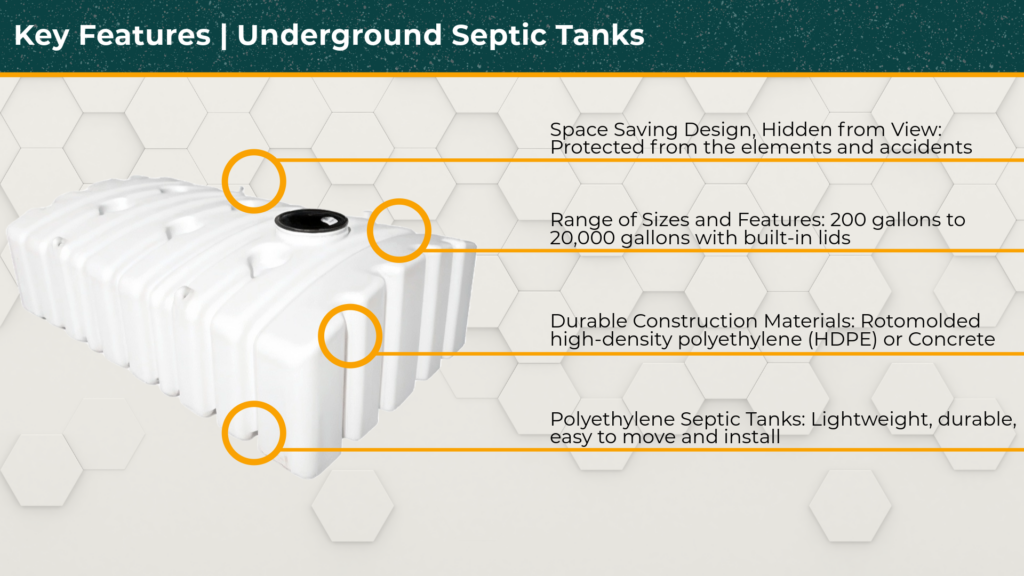
- Space Saving Design, Hidden from View: Underground septic tanks are installed below the surface, integrating with the landscape. This helps maximize usable yard space and preserves the visual appeal of the property.
- Protection From External Elements: Being buried protects these tanks from external factors such as harsh weather, extreme temperatures, and accidental physical damage. This shielding results in a longer lifespan and fewer maintenance concerns due to environmental exposure.
- Durable Construction Materials: Underground septic tanks are typically made from strong materials, commonly concrete or polyethylene.
- Concrete provides exceptional strength, making it a popular option for large capacity tanks.
- Polyethylene offers strong resistance to rust and chemicals and is lightweight for easy transport and installation.
- Polyethylene Septic Tanks: The underground septic tanks offered by National Tank Outlet are made from high density virgin polyethylene resin and are rotationally molded for a seamless, highly durable product. The tanks are impact resistant and strong for long lasting performance. Polyethylene septic tanks also include UV inhibitors to prevent sunlight damage when kept outside and preparing for installation.
- Range of Sizes and Features: Underground septic tanks are available in a wide range of sizes, from 200 gallons to 20,000 gallons, with options available for both residential and commercial applications. Many tanks come equipped with lids and pre-installed 4″ inlet and outlet ports to simplify plumbing connections. For better access, optional features such as manway extensions and risers can be included.
Common Uses and Applications
- Residential Properties: Underground septic tanks are a popular choice for permanent homes located in areas without sewer connections.

- Commercial and Industrial Properties: Businesses producing significant wastewater, such as hotels, restaurants, shopping centers, or industrial facilities, often rely on underground septic tanks for their high capacity and durability.
- Municipal and Rural Settings: For rural and municipal areas that need long term wastewater storage, underground tanks provide an excellent solution. They are particularly well suited to properties with adequate space and permeable soils.
Advantages for Various Conditions
- High Groundwater or Flood Prone Areas: Properly installed underground tanks can remain stable and functional even in challenging soil and environmental conditions, like areas prone to high water tables or floods.
- Large Wastewater Needs: Tanks with higher capacities, such as the 5000 gallon to 20,000 gallon models, are designed to handle the demands of larger households, multi-family residences, or businesses.
- State Approved Tanks: Many of these tanks meet specific state code requirements, ensuring they meet the necessary local regulations for septic system installations.
Whether for a residential home or a commercial property, underground septic tanks offer a durable and discreet solution for wastewater management. Explore National Tank Outlet’s extensive selection of underground tanks crafted to withstand diverse conditions and meet your permanent installation needs.
Comparing Above Ground vs Underground Septic Tanks
When deciding between above ground and underground septic tanks, let’s understand how these systems are different. Below, we will look at their differences in installation, durability, maintenance, aesthetics, and cost.
Installation
Above ground septic tanks are far easier and quicker to install than their underground tank counterparts. Since no excavation is required, the process involves fewer steps, lowering both labor time and overall installation costs. This simplicity makes above ground tanks an excellent choice for those seeking a cost effective or temporary solution.
On the other hand, underground septic tanks require significant site preparation, including soil excavation, proper leveling, and backfill process as well as permits, inspections, and other possible requirements. While more complex and costly to install, this additional effort results in a system that is established, secured in place, protected, and integrated with a property, making it a better option for permanent installations.
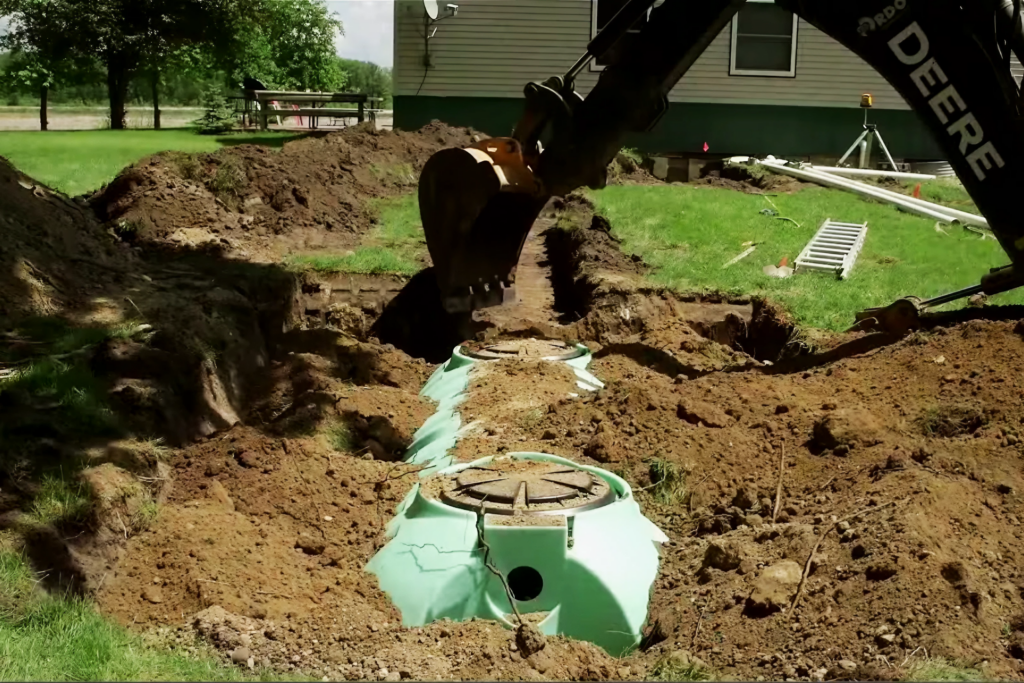
Durability and Longevity
Above ground tanks can potentially be more exposed to the environment, which can impact their lifespan. However, most are kept under job trailers, decks, or within crawl spaces. In exposed locations, weather-related wear, direct sunlight, or physical damage from objects or machinery are all concerns to consider. To mitigate this, they are often built from durable materials, but exposure can still make them more vulnerable over time.
Underground tanks, in contrast, benefit from being buried as this shields them from most environmental threats. However, they are not entirely risk free as they can face potential damage from driving over or soil pressure from tree roots and shifting ground, especially in areas prone to earthquakes or flooding. Proper installation and professional site evaluations can help address these risks and ensure long lasting performance.

Maintenance and Accessibility
Maintenance and repairs are major considerations when owning a septic tank. Above ground septic tanks are accessible and easy to inspect, allowing for faster troubleshooting and simpler repairs. This convenience is especially beneficial for routine care and emergency scenarios. In catastrophic loss situations, above ground septic tanks are significantly cheaper and easier to replace.
Underground septic tanks, while protected, require equipment to excavate the area when significant maintenance work is needed. This added complexity will make repairs more labor intensive, time consuming, and costly. Still, with regular inspections and pumping, underground tanks typically operate for years without major issues.
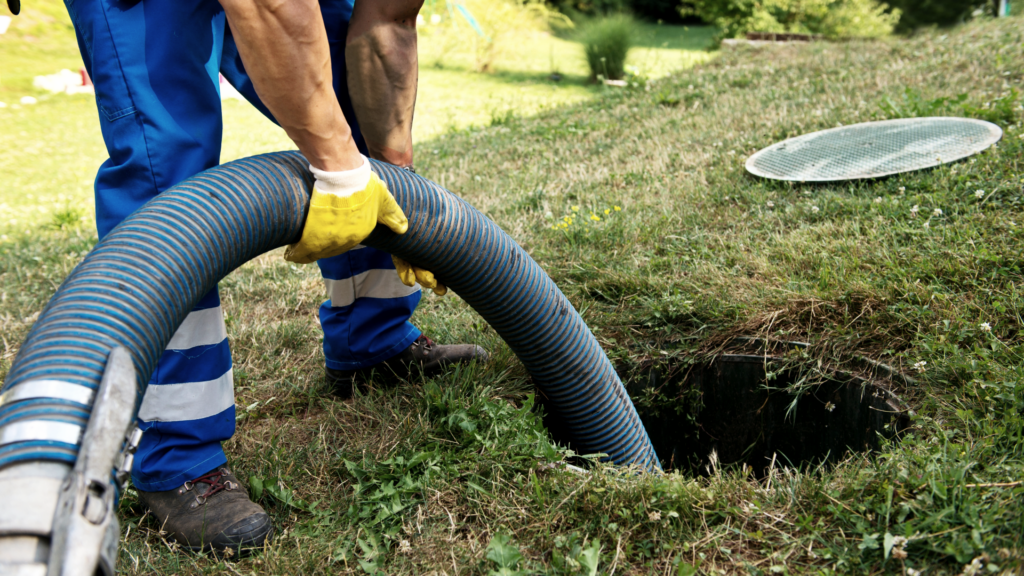
Aesthetic and Space Considerations
Above ground septic tanks are visible and can take up valuable land space, which may not align with the preferences of some property owners. They can be camouflaged with landscaping or protective coverings, but they often remain a prominent feature of the property.
Underground septic tanks, in contrast, are completely hidden, preserving the appearance and functionality of outdoor spaces. This allows homeowners to fully utilize their yards for regular activities.
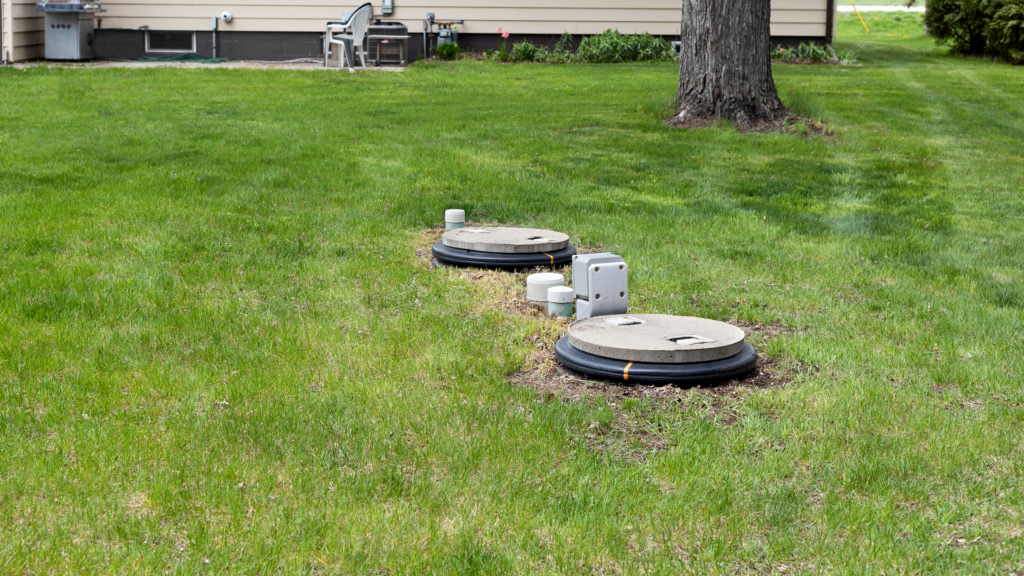
Cost
Cost is another point to consider when choosing between above ground and underground septic tanks, but this is not usually a primary consideration as the tanks are typically employed in entirely different use cases.
Above Ground Septic Tank Pricing
Available above ground septic tanks are generally more affordable due to their simpler design and easier installation process.
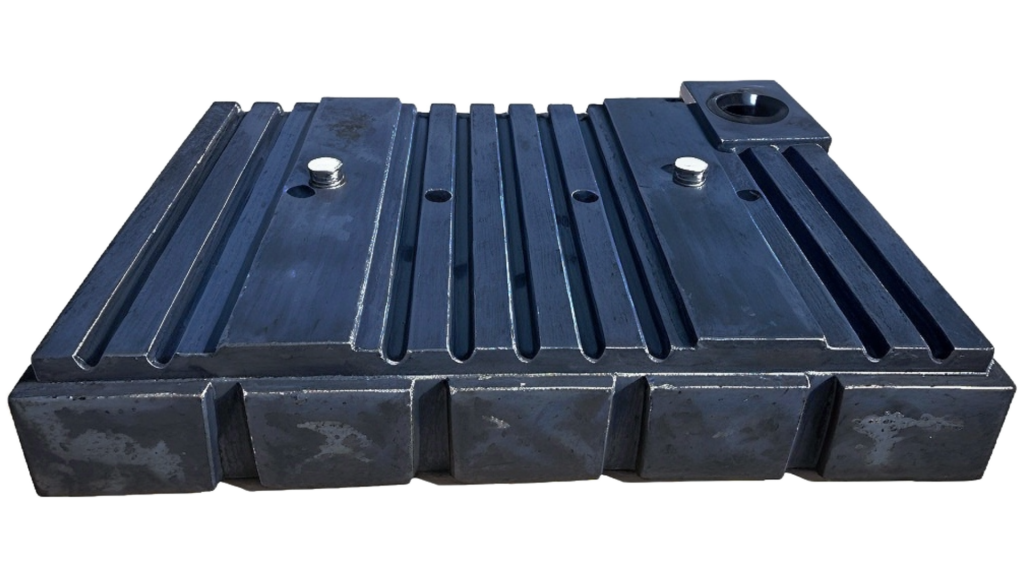
- Price Range: Above ground tanks are available at prices starting from $300 for smaller sizes, such as 105 gallon models, and go up to $2800 for larger tanks with a capacity of 1000 gallons.
- Capacity and Pricing: Medium sized tanks, such as the 500 gallon models, typically fall within the range of $1000 to $1500, providing an excellent balance of capacity and cost for most temporary or off-grid requirements.
Underground Septic Tank Pricing
Available underground septic tanks are designed for permanent installations and have higher durability, resulting in a higher price point.
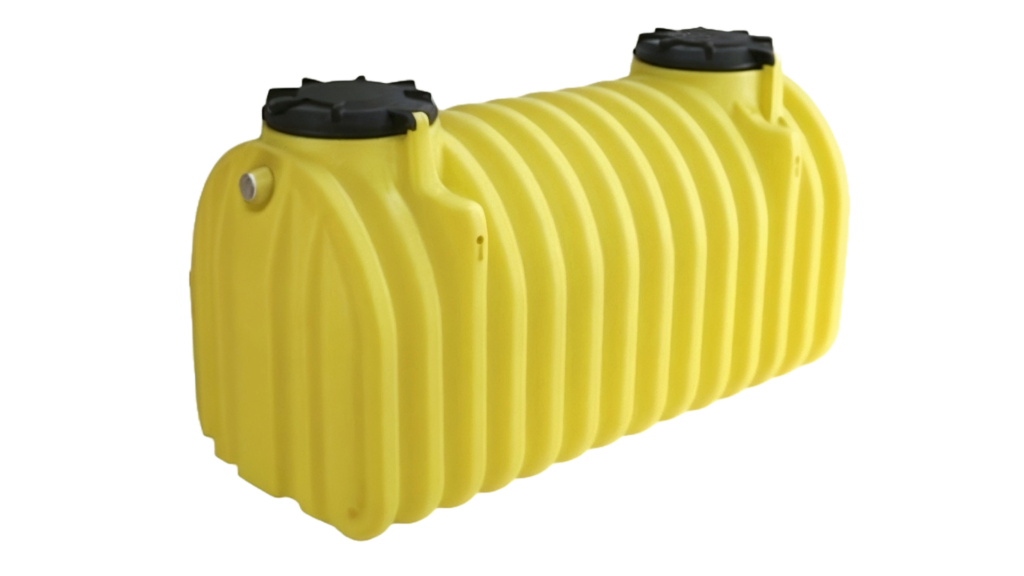
- Price Range: Underground septic tanks start at $500 for smaller tanks with a capacity of 200 gallons and can cost upwards of $3000 for larger, 1500 gallon models.
- Capacity and Pricing: Tanks in the 1000 to 1500 gallon range, often used in residential applications, are available within $2000 to $3000 and are a reliable investment for long term use.
Maintenance Tips for Both Types
Proper maintenance is essential for both above ground and underground septic tanks to keep them from becoming overly full and to keep them working. By following these maintenance tips, you can avoid costly repairs and maintain a smoothly functioning system, whether your tank is above or below ground.
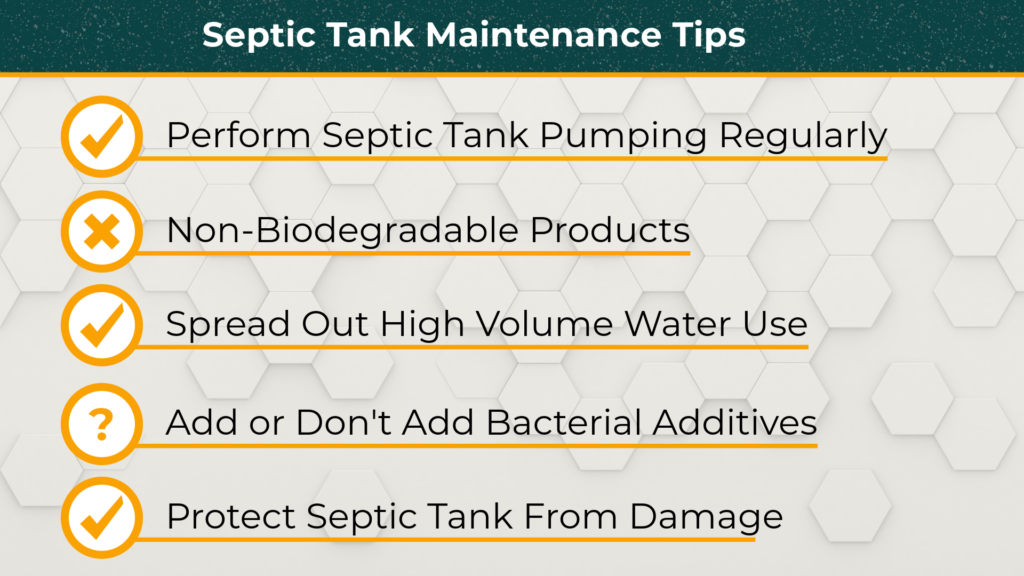
Regular Pumping and Inspections
Both types of septic tanks require regular pumping to remove the buildup of solids that cannot decompose naturally. Depending on the size of the tank and the property’s water usage, pumping is typically recommended every 2 to 5 years. It’s also recommended to schedule professional inspections to check for potential issues such as leaks, clogs, or structural damage. Routine maintenance helps fix and address these problems early before they worsen.
Avoid Overloading Underground Tank Systems
Overloading a septic system with excessive water or waste can lead to backups and can even stop system operation. Prevent such issues by spreading out high water usage activities, like laundry and dishwashing, over several days. Also, be mindful of what gets flushed — avoid disposing of non-biodegradable items, grease, or harsh chemicals, as these can disrupt the natural bacterial processes within the tank.
Bacteria Additives
Septic tank bacteria additives are not recommended for underground tanks. Conventional septic tanks rely on bacteria to break down solid waste, and bacteria additives can actually harm or disrupt this cycle. Some bacteria additives can be beneficial to above ground septic tanks to help boost the decomposition of stored wastewater since they do not function the same as above ground septic tanks. Make sure to use products that are safe and designed specifically for septic systems to avoid any adverse effects.
Protecting Above Ground Tanks
Above ground tanks are more vulnerable to weather and physical damage, so consider taking certain preventive measures.
- Extreme Weather: Cover the tank with insulation or protective coverings during temperature extremes to avoid freezing or overheating.
- Physical Damage: Keep heavy equipment, vehicles, and machinery away from the area to prevent accidental collisions that could crack or damage the tank. Consider installing barriers or fencing to protect the system.
Ensuring Proper Care for Underground Tanks
Underground tanks, while protected from external elements, still require specific attention.
- Proper Soil Coverage and Drainage: Ensure the tank is properly backfilled and covered with the right soil to protect it while allowing for proper drainage. Poor drainage can lead to water pooling around the tank, adding unnecessary pressure and potentially causing damage.
- Tree Root Management: Avoid planting trees or shrubs with large root systems near the tank or its drain field to prevent roots from potentially causing damage.
Frequently Asked Questions (FAQ)
How often should I pump my septic tank?
Septic tanks should be pumped every 2 to 5 years, depending on the type of tank, the size of the tank, and how much the tank is being used. Regular pumping removes sludge buildup, and in above ground septic tanks, removes wastewater so the setup can continue to be used.
What are the signs of septic tank failure?
Common signs of septic tank failure include slow drains, sewage backups, unpleasant odors near the tank or drain field, unusually lush or wet patches in your yard, and standing water around the system. If you notice any of these issues, contact a professional immediately.
Can I install a septic tank myself?
While some may be tempted to install a septic tank on their own, it’s highly recommended to hire a licensed professional. An above ground septic tank is easier and more straightforward to set up, making it potentially more suitable for self-installation.
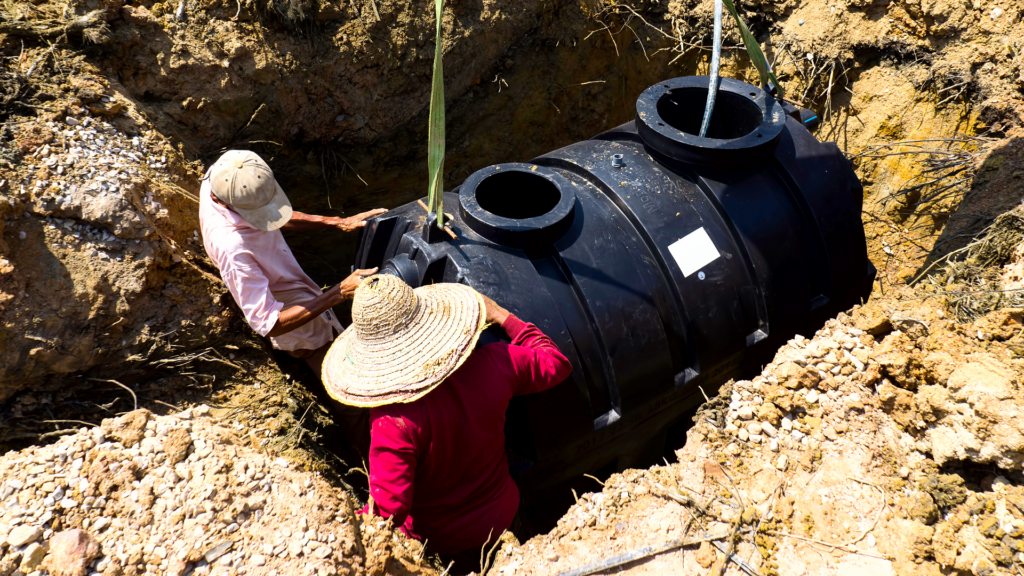
On the other hand, underground septic tank installation involves complex tasks such as soil evaluation, proper placement, and compliance with local regulations. Some states in the U.S. do not allow DIY installation due to the complexities, potential hazards, and damages that can occur.
We have compiled underground septic tank requirements for various U.S. states, including whether DIY install is allowed, if interested, you can find these posts here.
What is the lifespan of a septic tank?
The lifespan of a septic tank will depend on its construction material, how well it was installed, and if regular maintenance is performed. Properly cared for septic tanks can last 20 – 30 years or more.
What is the best temporary setup tank?
The National Tank Outlet’s above ground septic tanks are ideal for temporary uses, such as on construction sites, during home renovations, or at seasonal properties. They are easy to put into place, portable, and perfect for short term waste management needs.
What is the best way to care for my septic system?
The best way to care for a septic tank is to perform routine maintenance and do not flush things that should not be flushed. Routine maintenance includes:
- Scheduling regular pumping and inspections.
- Not overloading the system with excessive water.
- Consider bacteria additives to aid waste decomposition in above ground septic tanks.
- Do not flush anything that will not decompose or break down and or that could harm the natural biological balance of the bacteria inside the tank.
Are above ground septic tanks safe in extreme weather?
Yes, but additional protection may be necessary. It also depends on the extent with extreme cold presenting the most concern. Extreme sub-freezing temperatures can cause an above ground tank to freeze that can damage the components or the tank itself which cannot be used if frozen. Consider insulating the tank in freezing conditions, also placing it in crawl spaces and under buildings can also help.
Can tree roots damage underground septic tanks?
Yes, tree roots can push into underground tanks, drain fields, and pipes where they can cause damages, leaks, disconnections, or blockages that can reduce system function or cause complete system failure. To prevent this issue, avoid planting trees, shrubs, or other vegetation with the potential for large root systems near the septic field.
What should I do if my septic tank overflows?
If your septic tank overflows, stop using water immediately and contact a septic service professional. An overflow could be caused by neglecting routine maintenance, blockages, or system failure. Addressing the problem quickly can minimize environmental risks and more repairs due to further damage.
Takeaway
Choosing between above ground and underground septic tanks is a decision that should be based on your unique needs. Above ground tanks offer easy installation, lower upfront costs, and portability, making them ideal for temporary or budget-heavy projects. On the other hand, underground tanks provide a space saving, long lasting solution that has a higher cost, more intensive setup, and is better suited for permanent installations.
For the best results, consulting with septic system professionals is always recommended. They can provide tailored advice, assess your property, and ensure proper installation.
Shop Now
Looking for high quality septic tanks? Explore the National Tank Outlet’s extensive selection of above ground and underground septic tanks. See our most popular 1000 gallon septic tank for permanent system needs. Or if you’re looking for a compact solution, check out our 105 gallon above ground tank. Visit our website to browse our products or contact our customer support team for guidance on finding the right solution for your needs.